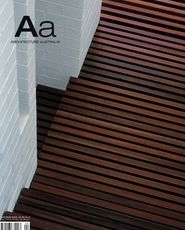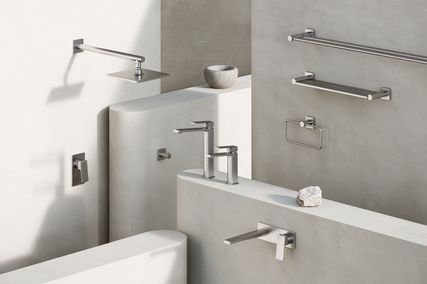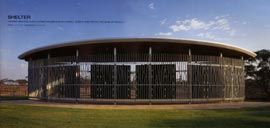
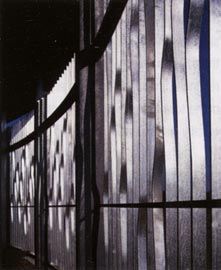
Detail of the waving steel screen enclosure. Image: Trevor Mein
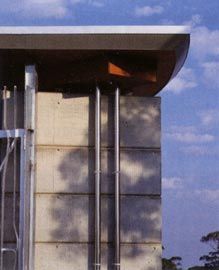
The articulated meeting of roof, crypt and screen. Image: Trevor Mein
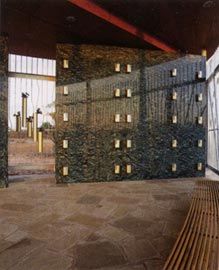
The figured green marble faces of the caskets, with the landscape beyond visible through the screens. Image: Trevor Mein
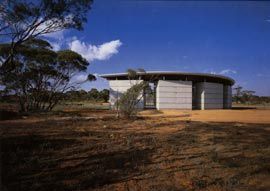
The solid forms of the mausoleum seen across the the landscape preservation area. Image: Trevor Mein
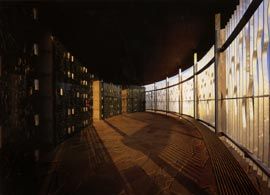
Internal view. Image: Trevor Mein
Harmer Architecture has completed a new mausoleum for the Murray Pines Cemetery in Mildura, Victoria, a building which will house 100 of Mildura’s dead.
Located on the edge of the town near the airport, the mausoleum is, like Mildura itself, a settled moment on the edge of the desert. Enclosed only by a fence, and containing one room, it is barely a building at all. The mausoleum is an architecturally difficult type here as it has little local precedent, and this site is also a difficult one – a place where such a building seems particularly unlikely. The value of this project is that it overcomes such difficulties, and avoids some cliches, to produce some real architectural presence.
The garden cemetery is such a dominant form in this country that it has been almost uncontested as a type in two hundred years of white burials. In fact, it is only in the last ten years that legislation has permitted mausolea here at all. (A measure of this rarity is the fact that the contractors were an American firm with relevant expertise.) New enough in the Melbourne suburbs, mausolea are perhaps even more unusual on a site with virtually no other buildings visible. At Murray Pines, the building is approached from a road through garden plots and headstones laid out in rows on the ground – a new site with no burials more than about five years old. Inside, four blocks each contain twentyfive caskets – five rows each sacked five high. The caskets are faced in highly figured green marble and each has a small gold anodized vase fixed to it. It is expected that the Italian community of Mildura will be its main purchasers – they get a place which is off the ground and part of a monument which is greater than any individual plot. The mausoleum stands as both a monument and a garden pavilion – a roof over an open space that faces a garden – in the tradition of special pavilions.
Mies van der Rohe’s German Pavilion at Barcelona springs to mind for comparison.
Not because this building is an essay on that project, but, superficially, for the dominant green polished marble, and also for the sense of partial enclosure. The palette of materials is also clearly articulated as planes. The crypt faces of marble, the sandstone floor, the plywood ceiling, concrete outer walls, and the steel columns are all clearly separated; there is no folding or blending between them. Of course, the differences between the two buildings are equally pronounced. In Mildura, Barcelona’s chrome columns become a grille of galvanized flats, dispersed and carry a waving line, and the travertine plinth has flattened to a floor plan, rusticated in a crazy-paved sandstone. At the same time, the roof is lifted off the walls, stretching the space vertically to about 4.5 metres. The horizontal trajectory between spaces and the glazed reflections of the Mies pavilion is replaced by something pointed upward and out to the sky. The effect is reversed, pushed into the ground and up into the sky and here, it seems just right.
It is often tempting for Australian architects to try to respond directly to the aesthetic of the landscape. It is a beautiful landscape here: red earth and small, delicate grey-green eucalypts. Not unique, but the kind of landscape which could stretch on everywhere. The mausoleum negotiates between this and the garden, and an idea of the urban, and manages to do so successfully. Rather than being like the bush, the building is simply figured after it, a leaf in plan. This gesture is only really evident after seeing the masterplan with a series repeated along branches, a giant garden with six big leaves – an organic city of six hundred.
This first mausoleum faces the edge of the landscape preservation area (the indigenous landscape is now protected) forming the junction between it and the start of the clipped garden. Entry is via a little-made path on the neat lawn to a gate – domestic in the suburban sense. As you face the marble, which is domestic in a grand sense, the bush appears through three gaps. It completes the wall, its light enters these gaps from the north and its wind blows through it. The bush is utterly unlike the solid blocks housing the hundred crypts, but its constant appearance is the key to the space. The solid blocks turn their back on the landscape, touching the earth as heavily as they need to.
The experience of an architecture like this involves some serious consideration of mortality. The architect both forces some confrontation, and allows some comfort. At Aldo Rossi’s necropolis in Modena we are confronted with a mass grave. In it, we are all the same, and it is the same mass grave we have been thrown into for centuries, and which seems to have no end. The comfort, paradoxically, lies in the constancy of this, in its inevitability, its collectivity.
At Mildura, one is contained in a more finite space, one shaped around a room, lined in rich materials. It feels like it might be a home. What we are confronted with though, is the thinness of the room, the absence of its skin and the insignificance of the situation. For all its apparent solidity, we can see the marble at its fine edge, hung on the concrete. For all its mass, it does not enclose us; it does not separate us from the desert.
I was there when a cool breeze was blowing, and the room provided only partial shelter.
The room is so barely a room: the arc of the steel grill shifts from being virtually solid to almost nothing; the sandstone is more a ground than a floor, conceptually a mere shadow of the roof. Around the solid crypts we a reminded always of what is outside them, as much as what is inside. There is an emptiness in all that which we need to reconcile. In the building, we are protected just enough, but not too much. Flying out of the town, the pavilion appears seems quite insignificant on the ground and then quickly disappears.
The strength of this work, and its interest lies in its translation from Harmer’s previous mausoleum design at the Faulkner Cemetery in Melbourne. The reduction in scale and the removal of interior enclosure have produced something quite different.
While it doesn’t make excessive claims for itself, it engages in a subtle debate about shelter. The client seems to appreciate this. I look forward to five more.
Credits
- Project
- Mausoleum, Murray Pines Cemetery
- Architect
- Harmer Architecture
Collingwood, Melbourne, Vic, Australia
- Project Team
- Philip Harmer, Andrew Briant, Grant Dixon, Merran Bent
- Consultants
-
Builder
Keith Miller & Sons in association with Milne Construction Australia
Structural and civil consultant GHD
- Site Details
-
Location
Mildura,
Vic,
Australia
- Project Details
-
Status
Built
- Client
-
Client name
Mildura Cemetery Trust

